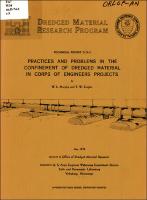Please use this identifier to cite or link to this item:
https://hdl.handle.net/11681/35733| Title: | Practices and problems in the confinement of dredged material in Corps of Engineers projects |
| Authors: | Murphy, William L. (William Lee), 1944- Zeigler, T. W. (Timothy W.) |
| Keywords: | Dikes (Engineering)--United States--Design and construction Dredging spoil--Waste disposal--United States Environmental engineering--United States Waste disposal sites--Environmental aspects--United States Dikes (Engineering)--Design and construction Environmental engineering Waste disposal sites--Environmental aspects Dikes (Engineering) Dredging Waste disposal in the ground |
| Publisher: | Soils and Pavements Laboratory (U.S.) U.S. Army Engineer Waterways Experiment Station. |
| Series/Report no.: | Technical Report (Dredged Material Research Program (U.S.)) ; no. Technical Report D-74-2 |
| Abstract: | Confined dredged material disposal problems and practices were discussed with representatives of 17 Corps of Engineers (CE) District offices to obtain a data base for subsequent related research efforts to be implemented by the Dredged Material Research Program at the U.S. Army Engineer Waterways Experiment Station and to disseminate the data to CE Districts and others. Although confined disposal of dredged material when compared with unconfined disposal is secondary in terms of quantity, it is increasing because of recent requirements for containment of dredged material that is considered polluted and the resulting curtailment of much open water disposal. A diminishing supply of suitable disposal areas, caused by filling of existing sites and difficulties in ·acquiring sites because of environmental or cultural constraints, has become a major problem of CE Districts. Long-range planning by some CE Districts has suggested three solutions to this problem: a.) Long-distance piping of dredged material to large disposal facilities. b.) Diking of disposal areas in water. c.) Possible acquisition of permanent disposal facility acreage by the Federal Government. Reuse of filled disposal facilities for agricultural, recreational, and industrial purposes, and for recycling of the dredged material itself is also being investigated by CE Districts and others. Dredged material is most often conveyed to confined disposal facilities hydraulically; that is, by pipeline dredge or by pumpout of hopper dredges, temporary rehandling basins, or loaded scows. Mechanical filling of areas by dipper, bucket, and ladder dredges is less frequent and usually supplementary to·hydraulic methods. Long-distance hydraulic pumping of dredged and similar materials has been shown to be feasible both by CE dredging experience and by nondredging industry-related applications. Size limitations on the material pumped, costs of equipment and personnel, and right-of-way acquisition difficulties are problems in the implementation of long-distance slurry transport. There are few efficient, well-designed facilities for the containment of dredged material. Channelization of dredged material from the discharge point to the sluice, the effects of wind, mounding and uneven distribution of dredged material, and retaining dike stability are common problems associated with containment facility operation. Present efforts in abating the above problems and in improving the efficiency of containment facilities consist primarily of the use of energy dissipating devices within the facility and the use of various sluice configurations. The sluices most commonly used are the drop inlet type, but siphons, outfall pipes, flumes, and filters are occasionally used. Odors and mosquitoes are sometimes associated with disposal operations and must be controlled. Effluent quality standards are generally set by the State and are most often density and/or turbidity requirements. At the time of this study, Federal pollution standards regarding effluent quality did not exist. Guidance in the matter of disposal facility effluent requirements is needed by CE Districts. Retaining dikes are primarily earth embankments constructed on lowland areas or nearshore islands. Several in-water containment facilities have been constructed, and in certain cases rockfill or slag has been used in dike construction. Retaining dike dimensions and composition vary considerably from District to District and within Districts. Dike characteristics are largely dependent on foundation conditions and available construction materials. However, these characteristics are also influenced by individual District policy regarding dike design and construction and available funding. The majority of retaining dikes are constructed as part of the dredging contract, although separate dike construction contracts are used in some instances. In the past, most Districts have left dike design and construction to the discretion of the dredging contractor. However, some Districts have taken a more active role in the control of design and construction because of damaging dike failures and encroachment on populated areas. Little or no information is available on the design of dikes constructed as a part of the dredging contract. CE design of retaining dikes is based primarily on past experiences. Thorough field and laboratory investigations and stability analyses are reserved only for special cases, such as containment facilities planned for long-range disposal and future development or facilities located adjacent to industrialized or populated areas. Dike construction is made difficult by generally poor foundation conditions and the use of low-quality borrow materials. Foundations of soft organic deposits are common. Dike fill is commonly placed loose by dragline with no compaction and often consists of previously deposited fine-grained dredged material with high water content. Hydraulic pumping of materials has been used to establish wide dike sections for support on weak foundations. Semi-compaction and stage construction of embankment fills and foundation displacement techniques have been applied to retaining dike construction. Retaining dikes often require continual maintenance. Failures have occurred largely because of poor foundation conditions and construction materials compounded by inadequate dike design, poor construction practices, and minimal inspection of dikes during dredging operations. The effects of seepage are directly responsible for or contribute to the majority of retaining dike failures. |
| Description: | Technical Report |
| Gov't Doc #: | Technical Report D-74-2 |
| Rights: | Approved for Public Release; Distribution is Unlimited |
| URI: | https://hdl.handle.net/11681/35733 |
| Appears in Collections: | Technical Report |
Files in This Item:
| File | Description | Size | Format | |
|---|---|---|---|---|
| Technical Report D-74-2.pdf | 25.8 MB | Adobe PDF |  View/Open |